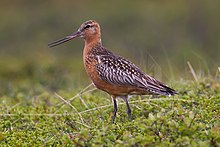Bar-tailed godwit
| Bar-tailed godwit | |
|---|---|
 |
|
| Breeding plumage | |
| Scientific classification | |
| Kingdom: | Animalia |
| Phylum: | Chordata |
| Class: | Aves |
| Order: | Charadriiformes |
| Family: | Scolopacidae |
| Genus: | Limosa |
| Species: | L. lapponica |
| Binomial name | |
|
Limosa lapponica (Linnaeus, 1758) |
|
The bar-tailed godwit (Limosa lapponica) is a large wader in the family Scolopacidae. The genus name Limosa is from Latin and means "muddy", from limus, "mud". The specific lapponica refers to Lapland. The English term "godwit" was first recorded in about 1416–7 and is believed to imitate the bird's call.
The bar-tailed godwit breeds on Arctic coasts and tundra mainly in the Old World, and winters on coasts in temperate and tropical regions of the Old World and of Australia and New Zealand. Its migration is the longest known non-stop flight of any bird and also the longest journey without pausing to feed by any animal.
The bar-tailed godwit is a relatively short-legged species of godwit. The bill-to-tail length is 37–41 cm (15–16 in), with a wingspan of 70–80 cm (28–31 in). Males average smaller than females but with much overlap; males weigh 190–400 g (6.7–14.1 oz), while females weigh 260–630 g (9.2–22.2 oz); there is also some regional variation in size (see subspecies, below). The adult has blue-grey legs and a slightly upturned bi-colored bill, pink at the base and black towards the tip. The neck, breast and belly are unbroken brick red in breeding plumage, off white in winter. The back is mottled grey.
It is distinguished from the black-tailed godwit (Limosa limosa) by its barred, rather than wholly black, tail and a lack of white wing bars. The most similar species is the Asiatic dowitcher.
There are three subspecies, listed from west to east:
It forages by probing in mudflats or marshes. It may find insects by sight in short vegetation. It eats mainly insects and crustaceans, but also parts of aquatic plants.
The bar-tailed godwit is a non-breeding migrant in Australia. Breeding take place each year in Scandinavia, northern Asia, and Alaska. The nest is a shallow cup in moss sometimes lined with vegetation. Both sexes share incubation of the eggs and care for the young.
The bar-tailed godwit migrates in flocks to coastal East Asia, Alaska, Australia, Africa, northwestern Europe and New Zealand, where the sub-species Limosa lapponica baueri is called 'Kūaka' in Māori.
...
Wikipedia

